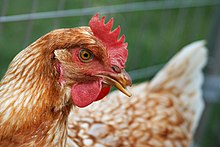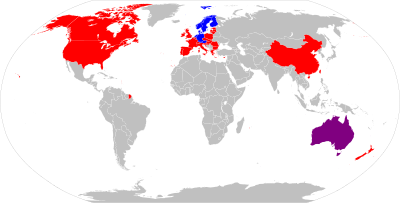Beak trimming
Beak trimming aims to avoid damage done by pecking, although the practice is criticized by animal welfare organizations and banned in several European countries.
Mortalities, mainly due to cannibalism, can be up to 15% in egg laying flocks housed in aviaries,[2] straw yards,[3] and free-range systems.
[citation needed] Cannibalism is a serious management problem dating back to the periods before intensive housing of poultry became popular.
[1] In the UK, beak trimming of layer hens normally occurs at 1-day of age at the same time as the chick is being sexed and vaccinated.
[citation needed] The US's UEP guidelines suggest that in egg laying strains of chickens, the length of the upper beak distal from the nostrils that remains following trimming, should be 2 to 3 mm.
[17][18] A 2019 Voiceless report recommended the NSW Parliament to prohibit debeaking and instead '[introduce] enriched environmental conditions, such as litter and suitable range areas [to] encourage interaction and mental stimulation for hens.
'[25] In a 2015 survey conducted by the Humane Society International Australia, 91% of respondents stated that free range egg boxes should display whether the hens had undergone beak trimming.
[27] Agriculture Minister Christian Meyer announced that Germany would phase out beak trimming by 2017 due to animal welfare concerns.
[7] A ban on beak trimming in the Netherlands was first announced in 1996, but due to objections from the poultry sector it was delayed for years.
[28] In June 2013, the government struck an agreement between poultry farmers and animal welfare groups to phase out debeaking and prohibit it in 2018.
The Code recommends that "[a]lternative strategies for managing injurious (feather) pecking that minimise the need for beak tipping should be employed e.g. use and availability of different foraging resources."
A late 2015 BTAG report endorsed by Farming Minister George Eustice concluded that banning it in January 2016 would be too early as the sector needed more time to change its management techniques in order to avoid feather pecking, but that beak trimming should be phased out in the future.
[31] Laying Hen Welfare Forum chairman Andrew Joret stated in March 2020: 'A ban is coming.
'[32] Beak trimming is legal in the United States, but there are some regulations: producers need to have a beak-trimming policy, it may not be employed to improve feed efficiency, but may be used to prevent cannibalism.
Most studies report reduced body weights and feed intake following beak trimming; however, by sexual maturity or peak egg production, growth rates are usually normal.
[40] The beak is a complex, functional organ with an extensive nervous supply including nociceptors that sense pain and noxious stimuli.
[43][44][45][46] In Japanese quail, beak-trimming by cauterization caused lower body weights and feed intake in the period just after beak trimming.
[55] The benefits of beak trimming are mainly welfare advantages for birds kept in close confinement, some of which directly relate to increases (or reduced decreases) in production.
[35][56] A range of options have been proposed as possible alternatives to beak trimming including modifying the genetics of domesticated poultry to reduce cannibalistic tendencies.
Enrichment devices, introduced at an early age, such as simple objects hung in a habitat, can reduce aggressive behavior.

